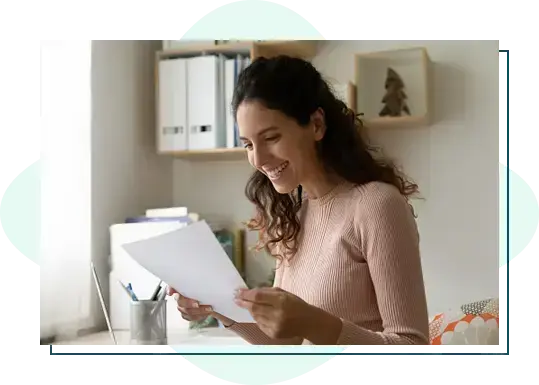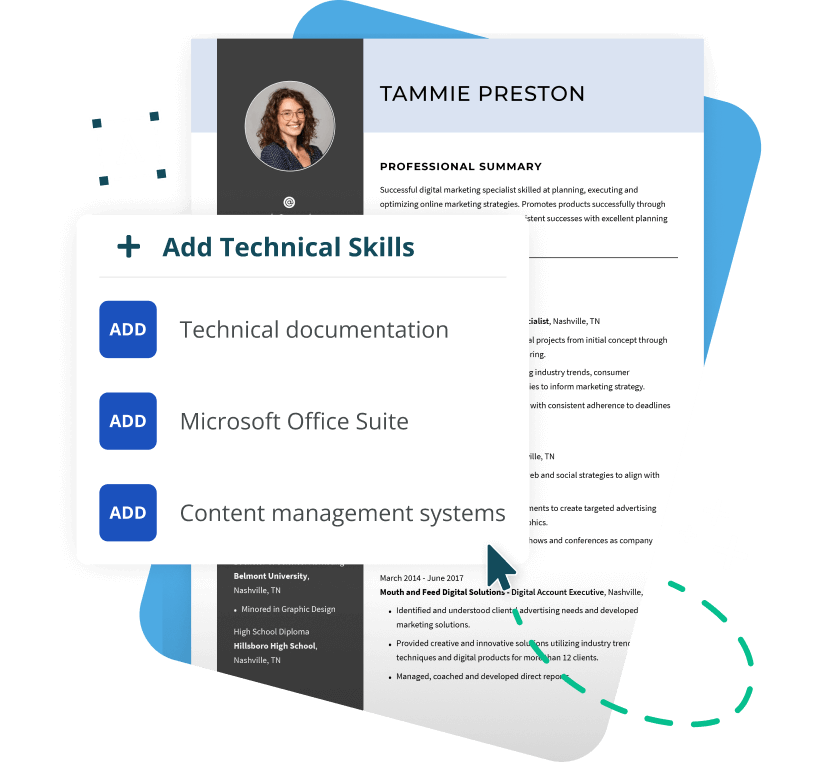- Featured in:
Want a better cover letter? Try our cover letter templates. Simply edit and download. Plus, you’ll get ready-made content to add with one click using our Cover Letter Builder.
Or view our sample cover letters made with our professional templates.
Business Letter Format
Your Name
Your Address
Your City, State ZIP Code
Your Phone Number
Your Email
Date
Recipient’s Name
Recipient’s Job Title
Recipient’s Company
Company Street Address
City, State ZIP code
Dear Mr/Mrs./Ms./Dr. Recipient’s Name,
Two to three sentences summarizing your letter’s purpose. This can be an interest in an open job, a leave request, a resignation or an update on business projects.
One-to-two paragraphs that outline the reasoning for your letter. This can be providing proof of your qualifications or explaining the business reasons for your leave of absence, resignation or recommendation.
A concluding paragraph summarizing your letter in two or three sentences.
Best,
Typed Signature
- Professional heading
- Date
- Addressee’s information
- Introduction
- Body
- Closing statement
- Signature
What is a Business Letter Format and Why is it Important?
A business letter format is the organizational layout in which information is presented in a printed letter. A letter format includes margins, line breaks and organization of each letter section. No matter your message, most documents follow a standard business letter format.
It’s important to follow a formal letter format to render these important letters professional-looking, easy to read and fit on a single printed page.
Common types of business letters include:
- Letter of intent: A formal letter of interest for a job opportunity or informational interview. Usually describes how your skills and experience add value to a workplace.
- Resignation letter: You may find a new job that aligns with your career interests, pay requirements, or upcoming relocation. A polite resignation letter helps you leave work and keep your professional connections.
- Leave of absence request: Occasionally, you may need some extended time away from work to pursue further education related to your work, take time for yourself or your family, or take medical leave.
- Recommendation letter: You may be asked to provide a letter of recommendation for someone.
- Email inquiry: This letter adapts the formal letter format to a digital landscape by omitting the mailing address and dates.
How to Write Formal Letters
Regardless of the type of letter you’re writing, a professional letter format always includes:
- Personal information
- Date
- Recipient’s name
- Introduction
- Body
- Salutation
- Signature
We created a few fill-in-the-blank format examples to help you draft your next official letters. To help you tackle formal cover letter formats, you’ll find letter templates with customizable greetings, letter content and sign-offs below.
Business letter format
This basic business letter template is used for most professional communications.
Your Name
Your Address
Your City, State ZIP Code
Your Phone Number
Your Email
Date
Recipient’s Name
Recipient’s Job Title
Recipient’s Company
Company Street Address
City, State ZIP code
Dear [Recipient’s Name],
I’m interested in [reason for writing the letter]. I would like to [explain purpose or request]. This is important because [provide brief explanation].
I am confident that [reason for interest]. Please see the attached [if applicable, mention any documents]. Feel free to contact me at [your phone number or email address] during [dates and times of availability] if you have any questions or need further information.
Thank you for your time and consideration. I look forward to [desired outcome].
Sincerely,
[Typed Signature]
Resignation letter format
Moving to a new job or career is exciting. A polite and respectful resignation letter can smooth your transition and help you keep your professional bridges with your soon-to-be-former coworkers.
Your Name
Your Address
Your City, State ZIP Code
Your Phone Number
Your Email
Date
Recipient’s Name
Recipient’s Job Title
Recipient’s Company
Company Street Address
City, State ZIP code
Dear [Recipient’s Name],
I am writing to formally resign from my position at [company name], effective [last working day, typically two weeks from the date of the letter].
I enjoyed working with the company and appreciate the opportunities for personal and professional growth. However, [provide a brief reason for resigning, if desired, e.g., relocation or new opportunity, new career goals].
I will work with my immediate supervisor and team to ensure a smooth transition during the next two weeks. I am grateful for the support and guidance I received at [company name].
Thank you for the valuable experience, and I hope our paths cross again.
Sincerely,
[Typed Signature]
Letter of intent
You can send a letter of interest or intent whether an employer is hiring or not. Use this letter to expand your professional network and search for professional opportunities. You can ask about upcoming job openings, get more information about the company or schedule an informational interview.
Your Name
Your Address
Your City, State ZIP Code
Your Phone Number
Your Email
Date
Recipient’s Name
Recipient’s Job Title
Recipient’s Company
Company Street Address
City, State ZIP code
Dear [Recipient’s Name],
I am writing this letter to express my interest [state your intention, e.g., pursue an information interview, apply for a position or submit a resume for future consideration.] with [company name].
My [mention relevant skills, qualifications, or experiences] make me a strong candidate/partner for [specific opportunity]. I am enthusiastic about [mention aspects of the opportunity that excite you].
I hope to discuss my potential contribution in an interview or meeting. Attached is my [if applicable, include any supporting documents].
Thank you for considering my letter. I look forward to hearing from you in the future. [If applicable, add dates and times to call and contact information.]
Best,
[Typed Signature]
Recommendation letter format
Once you establish your career and competence, you can use your reputation to recommend previous colleagues or classmates. This formal template can help you make a professional case for your connections.
Your Name
Your Address
Your City, State ZIP Code
Your Phone Number
Your Email
Date
Recipient’s Name
Recipient’s Job Title
Recipient’s Company
Company Street Address
City, State ZIP code
Dear [Recipient’s Name],
I am writing to highly recommend [name of the person you recommend] for [purpose of recommendation, e.g., employment, academic program, etc.].
I worked with [recommendation’s name] for [duration of your professional or academic relationship]. During this time, [his/her/their] [mention specific skills, qualities, or achievements] continually impressed me. The following accomplishments convince me that [he/she/they] could be a valuable addition to the team:
[Provide examples and specific details that illustrate the person’s qualifications and strengths].
[Conclude by summarizing your recommendation and expressing confidence in the person’s abilities].
I believe [recommendation’s name] would be a valuable asset to [company or institution name] and can confidently recommend [him/her/them].
Feel free to contact me with any questions.
Sincerely,
[Typed Signature]
Email inquiry
You may send formal letters through your email. Unlike the previous business letter formats, a standard email doesn’t include mailing information or sent date because the digital tool already includes your online contact information.
Subject Line:
[Your Name] — [Reason for Writing, e.g., Requesting a leave of absence MM/DD/YYYY]
Email Body:
[Greeting]
Introduction that summarizes your reason for writing. Add two key specifications.
The second paragraph will quickly outline your previous contributions, potential contributions, or business proposal.
[Sign off]
[Typed Signature]
[Secondary Contact Information, e.g., alternate email or phone number]
Letter Format Tips
Your professional letter should be informative but brief. The following formatting tips and writing advice can keep your letter detailed and easy to read.
Letter Formats FAQ
What is the most common letter format?
The block letter format is a formal writing style where your entire text is left-aligned. Include clear line breaks between each section and paragraphs.
What are the three basic letter formats?
The three basic letter formats are:
- Block: Every line is left justified and starts at the margin. Each line is single-spaced except for a double space between paragraphs.
- Modified block: Every line is left justified and starts at the margin, except your date and salutation. Hit the tab key until you reach the center of the page (typically four tabs).
- Semi-block: Every line is left justified, but each paragraph starts with an indent. Hit the tab at the start of each new paragraph.
What are the major parts of a business letter?
Most formal letters will include seven sections regardless of your business letter format:
- Heading
- Date
- Addressee’s information:
- Introduction
- Body
- Salutation
- Signature
The only exception is a formal business email. A letter pasted to an email body will include:
- Subject line
- Greeting
- Introduction
- Body
- Salutation
- Signature
- Alternate contact information





